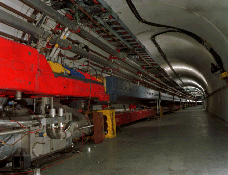
The Need for Large Accelerators
An Article Written Originally for Midlevel Teachers
Back
In order to study small particles, a high energy beam of particles must
be generated. The reason is that the higher the energy, the more finely
penetrating and discriminating a particle probe can be and the smaller the
structure that can be studied. Also, the more energy (mass) available, the
more new or more massive particles can be created in a collision of the
particle with a target particle.
Fermilab produces charged particle (proton) beams with billions of electron
volts of energy to study the make up of particles in the tiny, dense nuclei
of atoms. Fermilab's 1985 modification to the one-mile diameter main ring
accelerator allow protons to reach 1,000 billion electron volts (GeV, G
for giga meaning 109), or one trillion electron volts (TeV, T for teva meaning
1012). The modified accelerator is called the Tevatron. The most recent
(1993) improvement is the addition of the Main Ring Injector. This will
increase the intensity (number of collisions per second) by a factor of
five and allow both fixed target and collider experiments to be run simultaneously.
Particles were first used to probe the inside of atoms in about 1910. Ernest
Rutherford used naturally emitted alpha particles from a radioactive source
to bombard thin gold foil. He found that most alpha particles passed through
the foil undeflected, while a few bounced back at sharp angles apparently
due to hitting tiny solid objects. This was the first experimental evidence
that there was a small, heavy, positively charged core to the atom and that
the rest of the atom was mostly empty space.
In the 1930s, 40s, and 50s the study of the nucleus (nuclear physics) grew
and included the details of the patterns of radioactive decay of nuclei
and the forces that hold the nucleus together. Particle physics, also known
as high energy physics, developed as a branch of nuclear physics to investigate
the structure of nuclear particles using high speed (high energy) particle
probes.
The first circular particle accelerators were small instruments
ranging in diameter from a few inches to a few feet. Two fundamental limitations
on particle speed required that larger accelerators be built to create the
higher energy particle-probes necessary to study nuclear particles.
- In circular accelerators such as Fermilab's, particle paths are made
to curve by a magnetic field passing vertically down through each section
of the accelerator ring. The faster the particle, the stronger the magnetic
field must be to keep the particle in a certain radius curve. However, there
are upper limits on how strong a magnet can be. By making the circle larger,
the particle can go faster while the magnetic field strength remains the
same.
- When charged particles travel in curved paths they give up energy in
the form of radiation such as light. The sharper the curve the particles
are forced to turn, the greater the energy lost to radiation. At some point,
all the new energy being input to the accelerator to push the particle faster
will be immediately radiated away with no net gain particle energy. By making
the curve more gentle (larger circle), the radiation loss is less and the
particles retain more energy.
Since forcing the charged particles to follow curves seems to be the source
of problems in accelerating a particle, why not accelerate them in a straight
line? This is done in the first stage accelerator, called the Linac, at
Fermilab and on a larger scale at the Stanford Linear Accelerator Center
in California. However, the advantage of the circular accelerator is that
each time around the circle the particles can be given a new push, similar
to the way a playground merry-go-round can be given many pushes by a person
standing in one place. To gain the equivalent number of pushes, a linear
accelerator would have to be incredibly long and expensive.
Each bunch of protons in the Fermi accelerator is pushed 50,000 times each
second by passing through just one "pushing station" on each four-mile
trip around the circle. The fully accelerated proton travel at more than
99.999% the speed of light and has more than 800 times its original rest
mass. The distance the proton travels in one second is four miles times
50,000 which is 200,000 miles, or the equivalent of eight trips around the
earth.
Back
